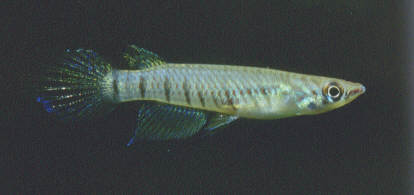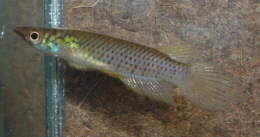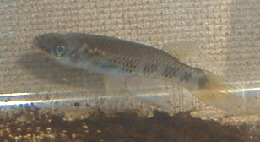Epiplatys longiventralis (Boulenger 1911)

Awka. Photo courtesy of Ed Pürzl.
| Meaning of Name |
After the long extensions to the ventral fins. |
||||||
| First Description |
Boulenger G.A. 1911. Descriptions of new African Cyprinodont fishes. Annals & Magazine of Natural History (8) 8 (44): p 266. |
||||||
| Size |
6.5 cm |
||||||
| Meristics |
|
||||||
| Karyotype |
|
||||||
| Sub-Genus |
|
||||||
| Group |
sexfasciatus |
||||||
| Synonyms |
|
||||||
Populations
|
|
||||||
| Type Locality |
Given as 'Swamps between Agwarba & Awka, southern Nigeria'. |
||||||
| Distribution |
Found in central southern Nigeria primarily around the Niger River delta. http://homepage.uibk.ac.at/homepage/c102/c102mr/epiplaty/longiven.htm |
||||||
| Habitat |
Swampy areas of small streams & rivers. Has been found with E.togolensis a closely related species. These two species are found in different areas of the biotope. E.longiventralis occupies the edges under marginal vegetation whilst E.togolensis occupies open water. |
||||||
| Distinguishing Characteristics |
Has long extensions to the ventral fins in mature specimens. Can be seperated from it's close relative E.togolensis by a stronger yellow body colour & an area of gold colouration on the frontal part of the body. E.longiventralis has a near black band around the lip, togolensis has a dark band on the chin as well as a band on the lower lip. E.longiventralis is also considered to be a more slender species. Populations of E.sexfasciatus from the Niger Delta (according to Scheel) are very similar to E.longiventralis. In fact he crossed these 2 species & found them fully viable. |
||||||
| Colour/Pattern Variability | Low. | ||||||
| History |
Arnold gives information in 1908 of a large shipment containing this species which were sent from the Niger Delta. Another import arrived in 1911. Both shipments were identified by Boulenger from preserved specimens as Haplochilus senegalensis (now a synonym for longiventralis). Also in 1911 Boulenger described Haplochilus longiventralis from 6 specimens collected by Gard'ner in swamps between Agwarda & Awka, north of the Delta. He also mentions Arnolds 1908 material as being 'referrable to longiventralis'. It would appear (according to Scheel in ROTOW 1) that no other reports of imports could be found until 1961 where Ulf Hannerz of Stockholm sent Scheel live fish he had collected in Nigeria. Boulenger gives the following collectors / locations in his 1915 Catalogue.
In the summer of 1961 Ulf Hannerz of Sweden collected near Benin City & labelled all Epiplatys E.grahami. It was found that these were E.longiventralis, E.sexfasciatus + 1 unknown female which later was identified as E.grahami. |
||||||
| Breeding Notes |
According to 'A World of Killies' by Ruud Wildekamp.......Regarded as a difficult species to breed. Reports suggest they lay eggs near the surface in plants or floating mops. Eggs may be sensitive & should be incubated in a seperate container. Water incubation takes about 12-14 days. Fry are large enough on hatching to take newly hatched brine shrimp. Growth is regarded as being slow with sexual maturity being attained at around 7 months. My initial attempts with TAAG 2003 / 8 produced
a good supply of eggs even in temporary quarters with hard water at
210 ppm & a pH of 8. Temperature was around 82°F. |
||||||
| Diameter of Egg | |||||||
| Remarks |
A species not often seen in the UK. Most come in as odd 'contaminents' in commercial shipments. I have distributed them from this source in the past. |

.jpg)

